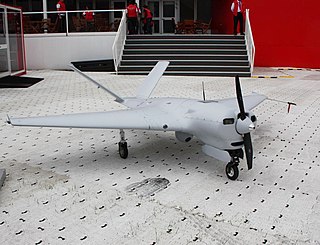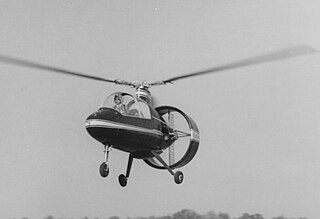Related Research Articles

An unmanned aerial vehicle (UAV), or unmanned aircraft system (UAS), commonly known as a drone, is an aircraft with no human pilot, crew, or passengers onboard. UAVs were originally developed through the twentieth century for military missions too "dull, dirty or dangerous" for humans, and by the twenty-first, they had become essential assets to most militaries. As control technologies improved and costs fell, their use expanded to many non-military applications. These include aerial photography, area coverage, precision agriculture, forest fire monitoring, river monitoring, environmental monitoring, weather observation, policing and surveillance, infrastructure inspections, smuggling, product deliveries, entertainment, and drone racing.

An autopilot is a system used to control the path of a vehicle without requiring constant manual control by a human operator. Autopilots do not replace human operators. Instead, the autopilot assists the operator's control of the vehicle, allowing the operator to focus on broader aspects of operations.

The Bell Aerosystems Lunar Landing Research Vehicle was a Project Apollo era program to build a simulator for the Moon landings. The LLRVs were used by the FRC, now known as the NASA Armstrong Flight Research Center, at Edwards Air Force Base, California, to study and analyze piloting techniques needed to fly and land the Apollo Lunar Module in the Moon's low gravity environment.

The Garmin G1000 is an electronic flight instrument system (EFIS) typically composed of two display units, one serving as a primary flight display, and one as a multi-function display. Manufactured by Garmin Aviation, it serves as a replacement for most conventional flight instruments and avionics. Introduced in June 2004, the system has since become one of the most popular integrated glass cockpit solutions for general aviation and business aircraft.

An aircraft stabilizer is an aerodynamic surface, typically including one or more movable control surfaces, that provides longitudinal (pitch) and/or directional (yaw) stability and control. A stabilizer can feature a fixed or adjustable structure on which any movable control surfaces are hinged, or it can itself be a fully movable surface such as a stabilator. Depending on the context, "stabilizer" may sometimes describe only the front part of the overall surface.
Cobham Limited is a British aerospace manufacturing company based in Bournemouth, England.
Parker Meggitt is a British international company specialising in components and sub-systems for the aerospace, defence and selected energy markets. It was listed on the London Stock Exchange and was a constituent of the FTSE 100 Index until it was acquired by Parker Hannifin in September 2022.

A miniature UAV, small UAV (SUAV), or drone is an unmanned aerial vehicle small enough to be man-portable. Smallest UAVs are called micro air vehicle.
A yaw damper is a system used to reduce the undesirable tendencies of an aircraft to oscillate in a repetitive rolling and yawing motion, a phenomenon known as the Dutch roll. A large number of modern aircraft, both jet-powered and propeller-driven, have been furnished with such systems.

The Learjet 31 is an American built twin-engined, high speed business jet. Manufactured by Learjet, a subsidiary of Bombardier Aerospace, as the successor to the Learjet 29, it has a capacity of eight passengers and two crew.
Chelton Flight Systems designs and manufactures advanced avionics and flight controls. Based in Boise, Idaho, Chelton Flight Systems originally started out as Sierra Flight Systems. The company was co-founded by Gordon Pratt and Rick Price in 1997. It is part of Genesys Aerosystems since 2014.

Avidyne Entegra is an integrated aircraft instrumentation system, produced by Avidyne Corporation, consisting of a primary flight display (PFD), and multi-function display (MFD). Cirrus became the first customer of the Entegra system and began offering it on the SR20 and SR22 aircraft in 2003 as the first integrated flight deck for light general aviation (GA). The original Entegra system was designed to use third-party components such as a GPS from Garmin and an autopilot system from S-TEC Corporation.
L-3 SmartDeck - is a fully integrated cockpit system originally developed by L-3 Avionics Systems. and acquired in 2010 by Esterline CMC Electronics through an exclusive licensing agreement.
The S-TEC Sentry is a reconnaissance unmanned aerial vehicle (UAV), developed in the United States in the 1980s. Built by S-TEC systems of Texas, it is a battlefield mini-UAV in roughly the same class as the BAI Dragon drone. In fact, the Sentry looks something like an Exdrone with a twin-boom raised tail. It is built of carbon composition and Kevlar, and powered by a 19.5 kW (26 hp) piston engine in a tractor configuration.

The DRS Sentry HP is a reconnaissance UAV that was developed in the United States in the late 1980s by S-TEC. The program was acquired by Meggitt in 2000 and subsequently by DRS in 2002. Although the aircraft shares the name "Sentry" with a previous S-TEC design, the Sentry HP is a completely different machine, with a broad wing and a V tail. The Sentry HP is larger, with greater payload capacity and an underwing stores capability. It is powered by a variant of the same engine as the Sentry. It can be ordered with an option for fixed landing gear to permit conventional takeoff and recovery.

The Avian 2/180 Gyroplane was a two-seat, single-engine autogyro built in Canada in the 1960s. Several prototypes were built but series production was never achieved.

The gyroscopic autopilot was a type of autopilot system developed primarily for aviation uses in the early 20th century. Since then, the principles of this autopilot has been the basis of many different aircraft control systems, both military and civilian.

The Grob G 120TP is a two-seat turboprop training and aerobatic low-wing aircraft with a composite airframe, built by Grob Aircraft. It is based on the Grob G 120A training aircraft and has been developed for military and civil pilots training. It has a retractable tricycle landing gear and a low tailplane.
An autonomous aircraft is an aircraft which flies under the control of on-board autonomous robotic systems and needs no intervention from a human pilot or remote control. Most contemporary autonomous aircraft are unmanned aerial vehicles (drones) with pre-programmed algorithms to perform designated tasks, but advancements in artificial intelligence technologies mean that autonomous control systems are reaching a point where several air taxis and associated regulatory regimes are being developed.
References
- ↑ Genesys Aerosystems Selected for Indonesian Aerospace CN-235
- ↑ Aviat Aircraft Unveils More Than a Dozen Enhancements
- ↑ Over 100 Models Approved for the S-TEC 3100
- ↑ ACQUISITION OF S-TEC CORPORATION AND S-TEC UNMANNED TECHNOLOGIES INC
- ↑ Meggitt to acquire S-TEC
- ↑ DRS Technologies Acquires Meggitt Defense Systems' U.S. Unmanned Aerial Vehicle Business
- ↑ "Unknown", Flying Magazine: 24, Feb 2008
- ↑ Cobham Buying S-Tec for $38 Million
- ↑ S-TEC and Chelton Flight Systems Acquired in MBO
- ↑ "Cobham Sells S-Tec and Chelton Flight Systems". Archived from the original on 2021-06-22. Retrieved 2014-08-26.
- ↑ "Genesys Aerosystems S-TEC 5000 Digital Autopilot & EFIS".
- ↑ "S-TEC 3100 Digital Flight Control System | Genesys Aerosystems".
- ↑ "Genesys Aerosystems Intelliflight 2100 Digital Autopilot & FMS". Archived from the original on 2017-03-28. Retrieved 2025-02-01.
- ↑ "IntelliFlight 1950 Autopilot | Genesys Aerosystems". Archived from the original on 2014-10-26. Retrieved 2025-02-01.
- ↑ "Genesys Aerosystems System 65 Analog Autopilot & Yaw Damper".
- ↑ "Genesys Aerosystems System 60-2 Autopilot, GPSS & Yaw Damper".
- ↑ "Genesys Aerosystems System 55X Autopilot, GPSS & Yaw Damper".
- ↑ "Genesys Aerosystems System 40/50 Autopilot, GPSS & Yaw Damper".
- ↑ "Genesys Aerosystems System 30ALT Autopilot & Yaw Damper".
- ↑ "Genesys Aerosystems System 20/30 Autopilot, GPSS & Yaw Damper".
- ↑ "Genesys Aerosystems SA-200 Digital Autopilot, GPSS & Yaw Damper".
- ↑ "Genesys Aerosystems ST-360 for Digital Autopilot & Analog Autopilot".
- ↑ "Genesys Aerosystems & S-TEC GPSSA Autopilot".
- ↑ "Genesys Aerosystems Yaw Damper for Avionics Systems".